Monkeys and Moksha
From the archives: An essay about how we view time, death and the afterlife.
I wrote this before Covid-19 hit, I was in the midst of travelling and felt like I’d written something that deserved to be read by more eyes than my small following, so I always meant to pitch it. But the world moves on, and this became relegated to the past. And yet, I have held onto it. Proud of the words and knowing that they are timeless, even if the relationship mentioned in this essay no longer exists.
Varanasi isn’t just a holy city, it is the holiest city. It isn’t just an ancient city, but the oldest city. Artists and travellers have been coming to the ancient relic called Varanasi, Benares, Kashi, or the City of Light, for millenia, if not longer. All intent to capture the dark magic that resides beneath the crumbling buildings.
I, like all those before me, came to Varanasi hoping to find that little spark, the secret that we’d forgotten in the bustling, time-poor world back home. I arrived after two sleepless nights to the heat of the Indian sub-continent. The road into the heart of Varanasi kept its Indian promise with beeping horns, shouting tuk tuk drivers, and cows disrupting traffic. I find my home at Babu’s guesthouse, nestled in the winding back streets of the city, amidst crooked and crumbling buildings three and four stories high. They’ve known for centuries how to build a city in a hot country. The alleyways are dark and cool. Monkeys visit the window, and Chaim, my partner, who flew here two months earlier, tells me he's been cultivating these simian friendships. He laughs and tells me he hasn't really talked to anyone else since he left Perth.
Cows meander in the street below and people touch them as they pass. They're holy animals. Dogs sleep on doorsteps. They're filthy, but you can tell that the people like them. We have to sidestep cow poo every few steps. An intense tiredness burns my eyes, and I have to turn around. I can't bear to visit the centre of the city’s activity, the burning ghats, on my first day. I will need more energy to watch the open cremations upon the banks of the Ganges. To watch what Hindus believe are souls being liberated from the cycle of endless suffering that is life, and returned to the fabric of the universe. I need a bit of preparation before entering that completely different world, before throwing off my social conditioning regarding what death is and how it should be dealt with. We retire back to our room overlooking the broken city and watch the monkeys. A new family wanders in, they climb the temples and leap through the air. Chaim tells me 11am and 5pm are prime monkey times.
We rise before the sun, as the Muslim call to prayer sounds out over a waking city. Dogs bark, monkeys chirp, the chai sellers start making their first batch of the day. I’m already sweating as we dress and wander down to the water in the early dawn light. As soon as we get to the waterfront, an elderly man asks if we want a boat. We nod, too tired to barter a cheaper price. A boy pulls the boat up and we climb on board, waiting for the man to step on behind us, but as the boat moves onto the Ganges, the boy leaps on instead, and as he picks up the oars, a wave of guilt rises and crashes: I’m utilising child labour.
I ask his name. It’s hard to make out his pronunciation, but I think I hear “Assam”. I ask his age: 13. I ask how long he's been working on the boats, and he says 4 years. He’s strong and he rows us along the Ganges, as the tropical sun rises, a red orb shining through the smoky haze of burning bodies. Birds fly in packs over the water, and boatloads of tourists sail by. The river is full of boatmen. We pass the early morning bathers, and the babas lighting up their first chillum of ganja for the day. A man stands knee deep in the Ganges, raising a handful of water to the sun in prayer.
The fires are already burning as our boat passes by. They’re always burning, hundreds of bodies a day according to the workers there. We sail past a city bathed in orange dawn light, and I bring my camera up to my eye and snap picture after picture, freezing time and immortalising this moment for myself. It goes against everything this city represents, but the camera is my filter to the overwhelming rituals of this place, to the burning bodies, to the raging tourism and the poverty. Until I can process it all, I’ll need this filter.



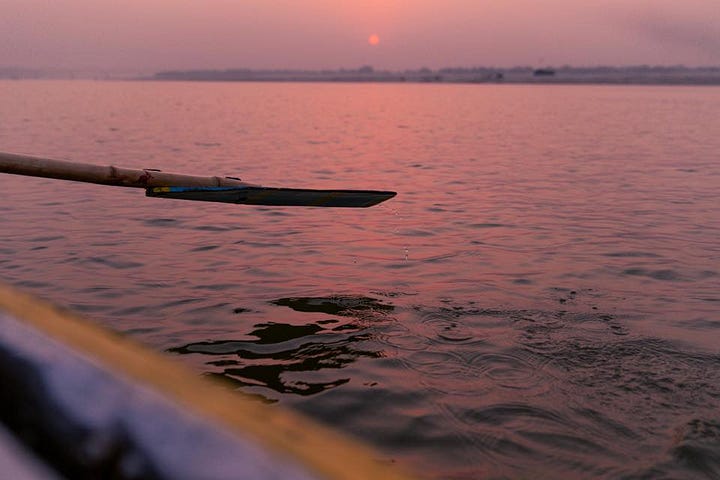

*
Chaim tells me the world can be broken up into two types of people, those “doing” and those “being”. As westerners, we come from a long line of doers. The people in India are more able to tap into the state of “being”, where there is no tomorrow, and no yesterday, only now. And that’s maybe part of the reason why everything is a little bit broken in India, but that’s also why people flock to find gurus, and why you can go sit on the ghats of Varanasi and talk to a homeless sadhu and learn a little more about the human condition.
There is no denying the poverty that dwells in this country, and yet, one can’t only notice the poverty. Old cultures have their own spark. It's not only the layers of history, the religion and rituals, but a difference in time. I come from a monochronic culture, where time is segmented, incremented into hours and minutes and seconds, and strictly regimented. And so, I am very aware of time passing. Of time running out. Of wasted time. I, like most people in my culture, experience time famine. Time is money. We live in tomorrow and next week and next year. We want our life to outlive us, our legacy to last. India, however, is a polychronic culture. Time is a much more fluid concept here. That's why the buses don’t run on time, and nobody has the same schedule, and I can’t really rely on everything to work the way I think it should. But that’s also why nobody really cares when the bus is late. Nobody cares if I accidentally interrupt traffic because I’m scared to step around an angry cow. Nobody really worries when the train takes 23 hours instead of 16 to get from Varanasi to Haridwar.

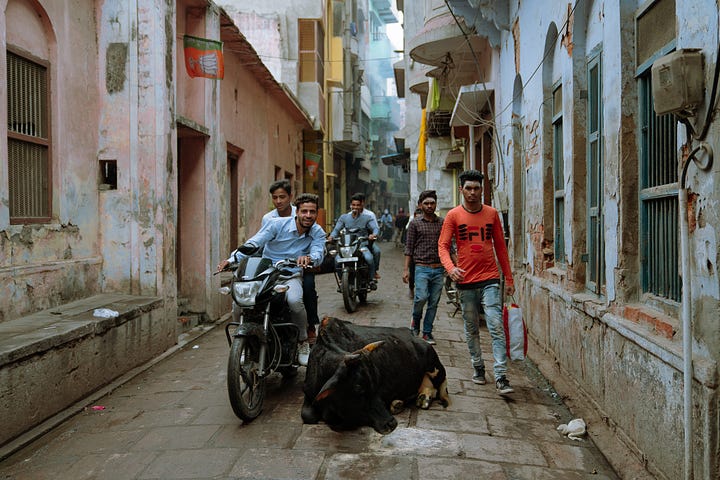

It's a constant struggle to turn off the “doing” part of my brain. Every day of my life strengthens the pathways. Every time I jump online, I’m reminded to be a better version of myself by doing, doing, doing. This is the city to practice my own meditation on letting go. It doesn’t hurt that I can’t find good wifi here.
I finally make it on foot to the Manikarnika ghat, the famous “burning ghat”. It’s surrounded by its own city of wood. Children carry in new bundles all day long. They belong to the caste of people who, for centuries, have brought wood to the burning bodies. A man wanders lazily over to us. His eyes are red and look vacantly through us, as if gazing at something we can't see. We tense up, knowing the common scam is about to hit us. He will ask us to donate money to the hospice, so that the poor can afford to burn themselves. The scam is that the money doesn’t generally end up at the hospice, but rather, in the pockets of the young men who dwell down here.
But he surprises us, as India often does. He tells us his life story.
He’s been bringing wood to the fires for twenty years, feeding the fires every day, as bodies burn and burn and burn. His father did it before him, and his grandfather before that. He claims that, as Brahmins, this was a sacred duty in his family, as well as their livelihood. He says that only the sacred fire is used to light the cremation pyres, and it’s been burning for a thousand years. As we stand talking to him, a procession of men carry a shrouded body down to the water, as it must be washed in the holy river before it can be burned. There’s a stoicism emanating down by the funeral pyres. Some of the faces down here are blank, others are fighting back tears. One young man even takes a selfie with whichever shrouded family member is laying on the ghat, half immersed in the water. For all the different emotions these faces express, everyone knows one thing: these cremations are meant to be a magical thing. To be cremated in Varanasi assures that the soul will receive moksha, which means, liberation from the endless cycle of existence. By being burned along the banks of this holy river, one can end the suffering that is life and return to the nothingness of the universe. Thousands flock here every year to die within the city of Varanasi. Trees upon trees are cut down to keep up the demand for wood. Ashes are forever flowing into the water. Sometimes an unburnt body part floats by, a last remnant of someone too poor to afford enough wood to completely burn their body.

The burning bodies, the smell of death, the mourners with shaved heads, shrouded in white: This can all be overwhelming, of course, to a person from a predominately Christian country, where everything is clean and separated and removed. Cremation has always made more sense to me than burial. I’ve never understood why we box ourselves up, embalm and completely remove ourselves from the natural order. Maybe it fits in with the culture back home, where everything is about prolonging. We are a nation of sweepers under various types of rugs. Everything we do back home seems aimed at avoiding suffering, while in India, suffering is everywhere. It’s in the eyes of the children in poor villages. In the face of women and men who work every day to provide for their families. In the scurry of the cats rushing past the fast moving feet where, at any moment, a well aimed kick might come. In the timid eyes of a holy cow navigating a busy city, among blaring horns and rushing motorbikes. Perhaps because one can’t turn away from the suffering, it feels less terrifying than it would back home. We shy away from death in the West, but I prefer to live my life with death on my mind. To live my life with an awareness that, at any moment, it could end. Rather than running from the God of death, I would prefer to channel my lookalike, Arya Stark, and say “not today my friend” and embrace the discomfort of a life well lived.
It’s not uncommon for a western traveller to have grandiose and overblown thoughts about life in a country like India, and especially in a city like Varanasi. As I walk beside the sacred river, I can’t help but think about the kind of life I’d like to have. To hug my mum when I can, and push my body when I can, and to work hard when I need to, but only when I need to, and to put a little more energy into being, rather than doing for the sake of doing, so that when my own body burns on whatever pyre I end up on, I have lived a life, rather than having watched a life slip by.
Back home we focus so much on how we would like our life to be. We chase happiness, and try to tailor our lives so that we can capture it in bottles, and place them permanently on shelves, and then fret and worry about whether they’re still there. Ironically, one of the central teachings in most schools of Indian philosophy is that grasping onto permanence is the root of sorrow, and that only by embracing the impermanence of life can one truly be happy. In Varanasi, all around me I see people living their lives, for the most part, as ordained by their caste, or by their family’s wishes. It would be naïve to think that many people upon these ghats wouldn’t envy my life back home, with its ease and comfort. That they wouldn’t envy my freedom to travel. That they wouldn’t wish to possess a few of the bottles I’ve collected. What a privilege it is, to be able to construct a life, free from many of the constraints of poverty and family obligation. But at the same time, most travellers can’t help but see how, in many ways, despite these hardships, the people here have a spark of joy that is very rare back home. Or perhaps this is just a projection, one of those overblown and grandiose epiphanies that so often come over a traveller, when confronted by such different realities of life.
And my mind returns to the world in front of me. I see another life burning away, turning to ashes and memories, surrounded by their family. Eventually, we wander back to Babu’s guest house, past the mourners. We walk past holy men, meditating on non-duality, embracing the notion that our body is only a vessel for the soul within. We wander past cows, through the alleyways, making room for a procession of men wearing lungis and banging cymbals and chanting to one of countless gods or goddesses this city is devoted to. As we reach our little home, we see the father of Babu in priestly garb, sitting at the bottom of our stairs, reading from a very old book, chanting as he feeds a fire. We ask the Indian family living below us which diety they’re celebrating tonight, and the young girl named Sneha says that it’s Shitala, who sweeps the darkness away with her broom.
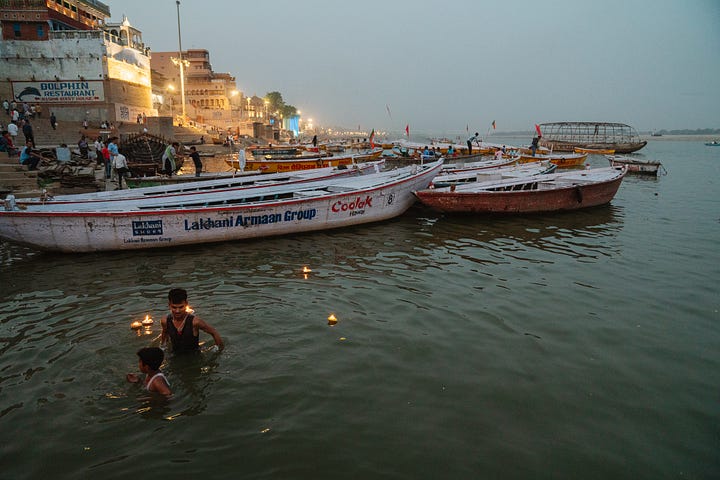
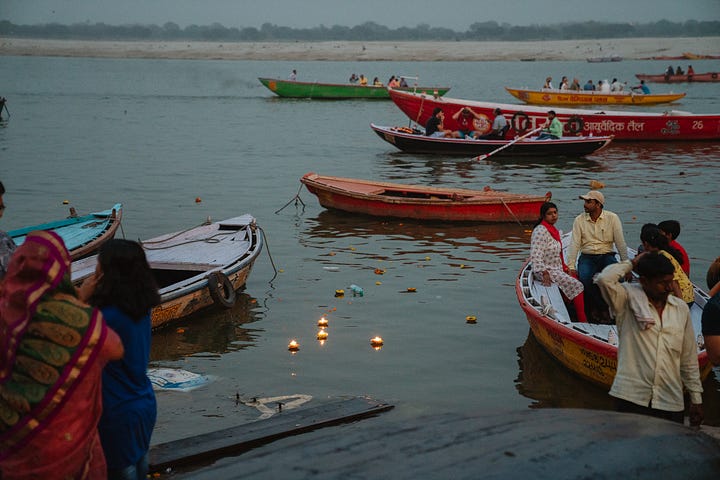


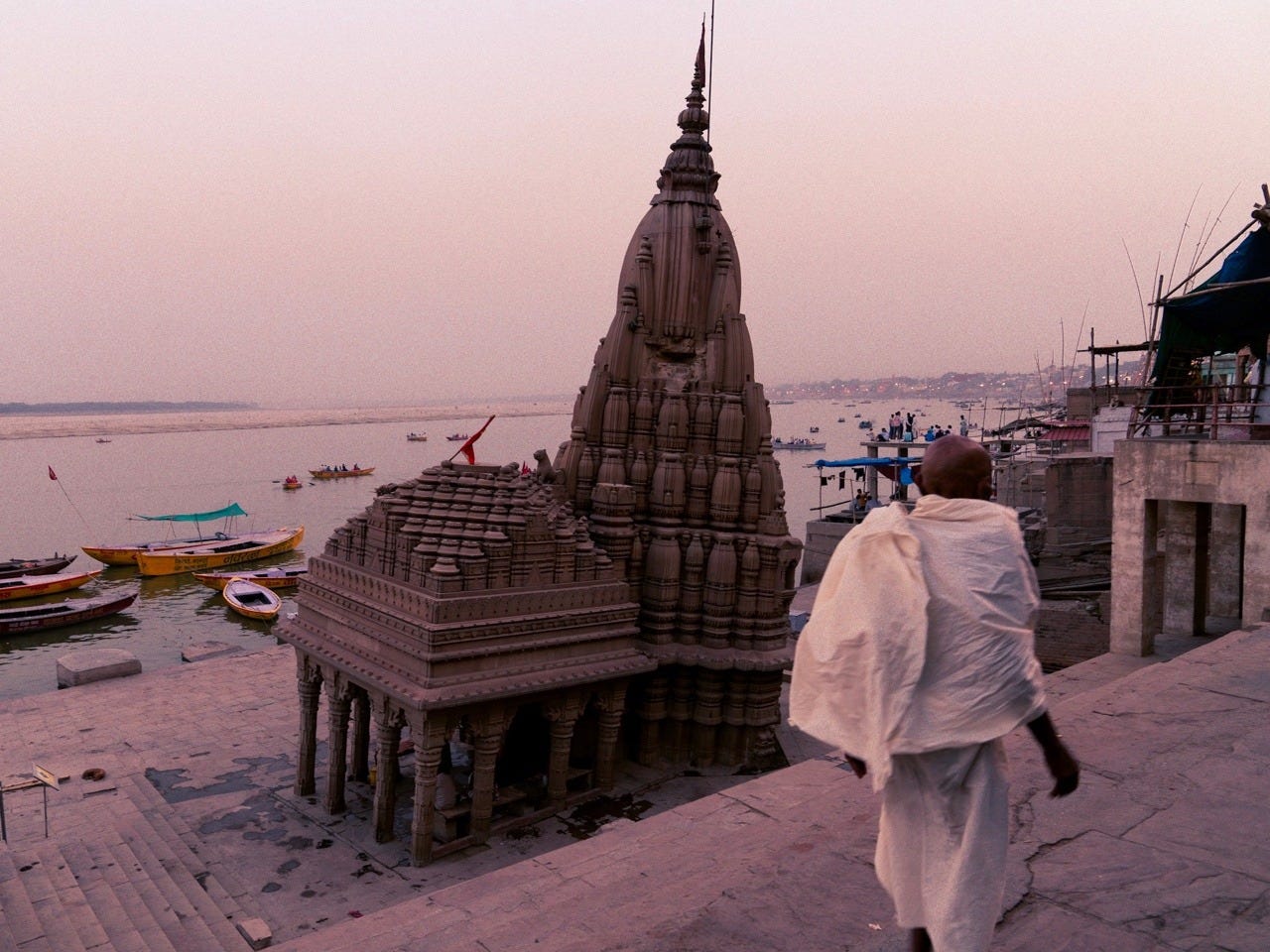
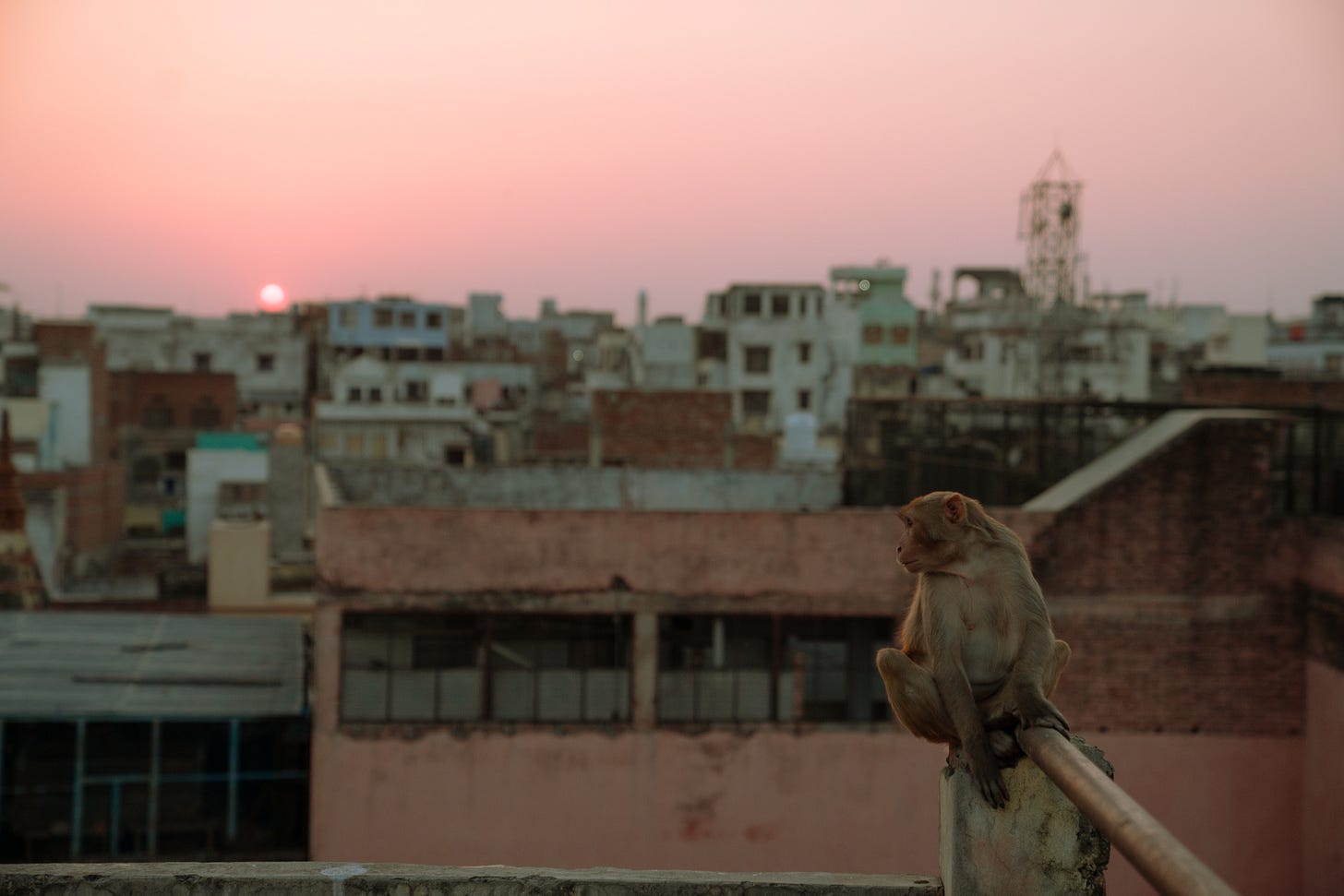

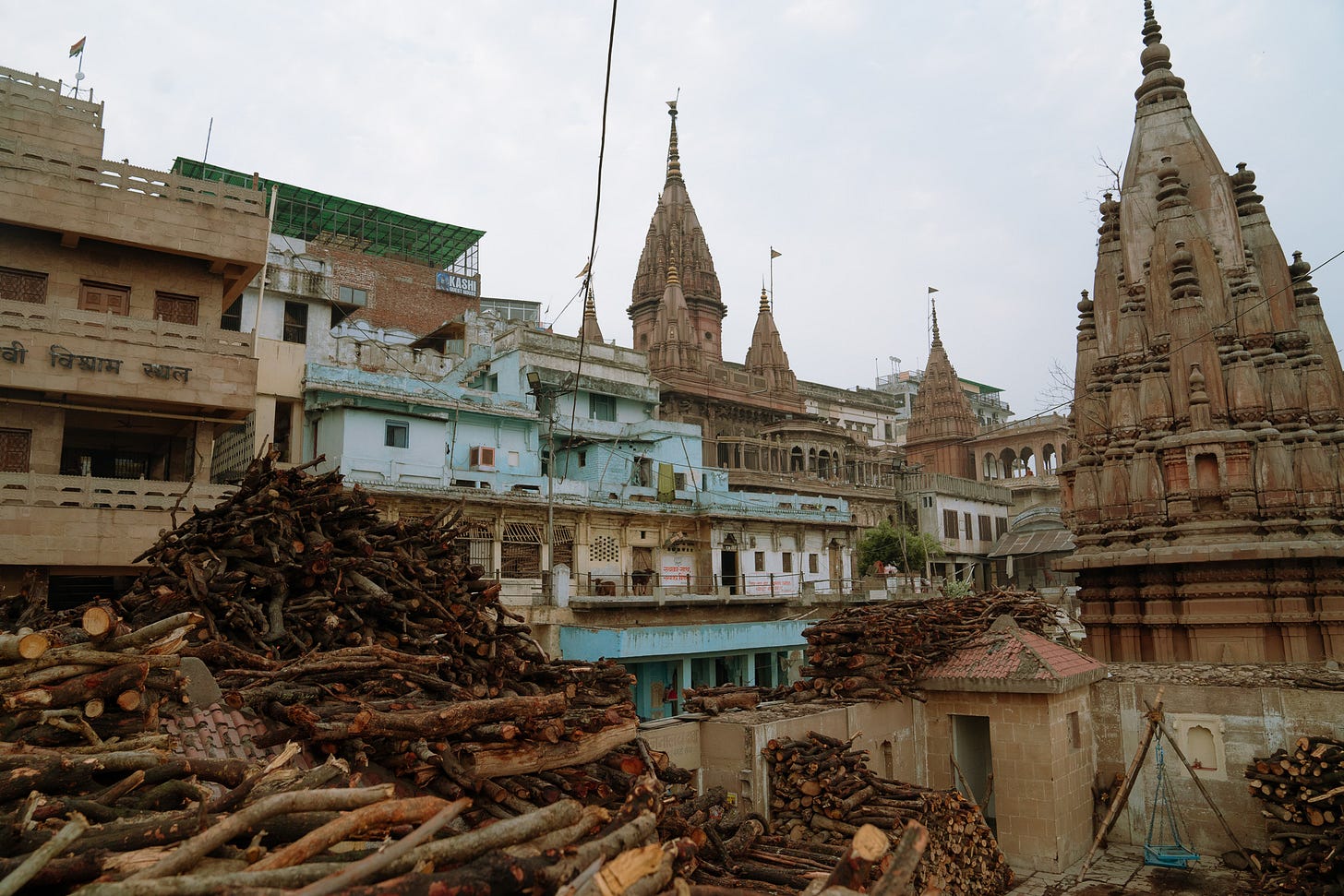
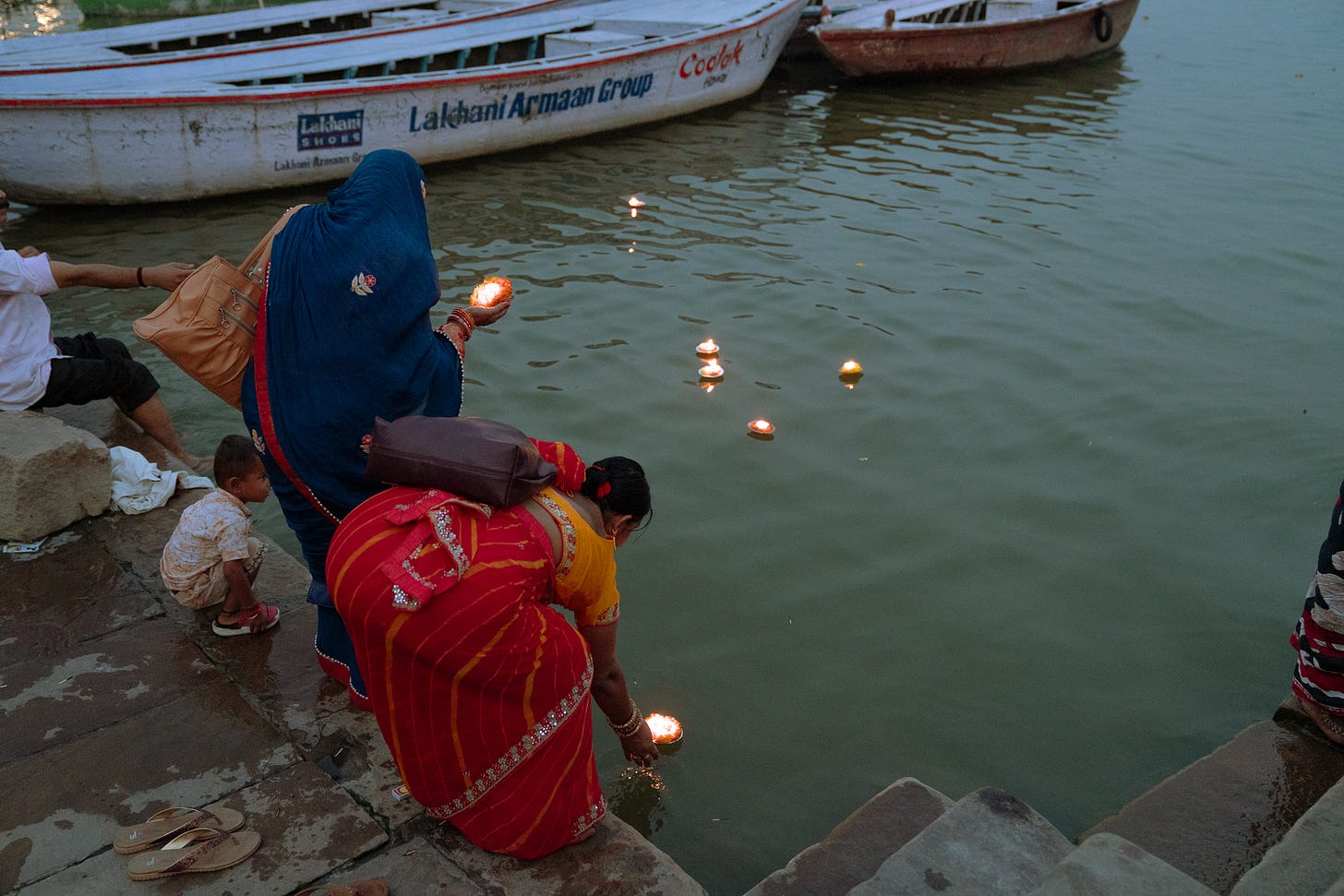
Louise- Thanks for sharing insights and pictures on Varanasi. Now I'd have to add it to my ever-growing list of places to visit before I die. Hope you're well this week? Cheers, -Thalia
Beautiful writing Louise! Isn’t Varanasi an amazing place.